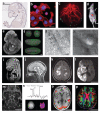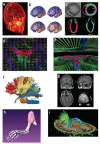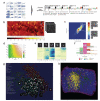Visualization of image data from cells to organisms
- PMID: 20195255
- PMCID: PMC3650473
- DOI: 10.1038/nmeth.1431
Visualization of image data from cells to organisms
Abstract
Advances in imaging techniques and high-throughput technologies are providing scientists with unprecedented possibilities to visualize internal structures of cells, organs and organisms and to collect systematic image data characterizing genes and proteins on a large scale. To make the best use of these increasingly complex and large image data resources, the scientific community must be provided with methods to query, analyze and crosslink these resources to give an intuitive visual representation of the data. This review gives an overview of existing methods and tools for this purpose and highlights some of their limitations and challenges.
Figures




References
-
- Moore J, et al. Open tools for storage and management of quantitative image data. Methods Cell Biol. 2008;85:555–570. - PubMed
-
- Cox R, et al. A (sort of) new image data format standard: NifTI-1. Neuroimage. 2004;22:99.
Publication types
MeSH terms
Grants and funding
- U54 EB005149/EB/NIBIB NIH HHS/United States
- E003443/BB_/Biotechnology and Biological Sciences Research Council/United Kingdom
- P41 RR013218/RR/NCRR NIH HHS/United States
- U54 RR021813/RR/NCRR NIH HHS/United States
- BS/06/001/BHF_/British Heart Foundation/United Kingdom
- WT_/Wellcome Trust/United Kingdom
- MC_U127527203/MRC_/Medical Research Council/United Kingdom
- RL1 CA133834/CA/NCI NIH HHS/United States
- BB/G000883/1/BB_/Biotechnology and Biological Sciences Research Council/United Kingdom
- R01 EB004155/EB/NIBIB NIH HHS/United States
- P41 RR013642/RR/NCRR NIH HHS/United States
- R01 EB004155-03/EB/NIBIB NIH HHS/United States
- 5 RL1 CA133834-03/CA/NCI NIH HHS/United States
- P41 RR13218/RR/NCRR NIH HHS/United States
LinkOut - more resources
Full Text Sources
Other Literature Sources

